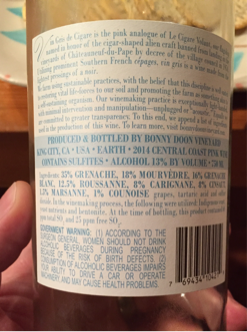|
An article from Eater.com which I read last month turned my attention to wine labels. The entire span of my drinking life has seen a proliferation of eye-catching labels and bottles. Many studies, such as the one cited in this article, reinforce the strength of dynamic labeling. "And a 2015 Gallo Wine Trends Survey found that millennials are four times more likely than Baby Boomers to buy a wine based on the label. They are looking for labels with originality and personality, while Baby Boomers pick labels based on region of origin and taste. Nielsen found a similar trend. Millennials want labels that are "bold and distinctive," while baby boomers want more traditional designs."
What, really, does a label (or the whole bottle's presentation) tell us? Certified wine professionals would point to European labeling rules as the ideal model. Understanding the label cues can lead to effective conclusions on wine quality before you ever drink it, as we're taught in WSET classes. However, a serious amount of studying and geography skills are required to effectively remember the vast difference between a Pouilly-Fuissé (Chardonnay from the Macôn region of Burgundy in eastern France) and a Pouilly-Fumé (Sauvignon Blanc from Loire in western France), or the difference between Vino Nobile di Montepulciano (red wine made from mostly Sangiovese near the town of Montepulciano in Tuscany, which is on the west coast) and Montepulciano d'Abruzzo (a red wine hailing from the Abruzzo region on the east coast made from the Montepulciano grape). For this reason, many importers have altered back-of-the-bottle labels on European wine to include the grape varieties for their "less sophisticated" American consumers. The American domestic wine industry came of age in the late 20th century with varietally-labeled wines, and it's shaped American consumers. I personally don't think that's a bad thing. However, in defense of the Europeans, once you learn the classification systems, it's a lot easier to understand that you'll likely get a better quality of wine when you buy a Chateauneuf-du-Pape AOC than a bottle of Côtes du Rhône AOC. The U.S appellation system is sometimes equally confusing. You must study the appellation maps and read wine reviews to understand that a Russian River Valley AVA Pinot Noir is generally of higher quality than one from the North Coast AVA (which can include fruit grown almost anywhere in six Nor Cal counties). For better or worse, the AVA (American Viticulture Area) designations don't have the same quality-based regulations that the European AOCs or DOCs do. For Americans without a deep knowledge of wine, the only way to tell that a Rochioli or DuMOL Pinot Noir is far superior to a La Crema Pinot Noir is the price tag. European consumers have the upper hand with quality guarantees, but U.S. wineries wouldn't fare well with a similar amount of encumbering regulations and classifications. Still, consumers lose in either labeling system. In my opinion, one of the biggest hurdles to the success and expansion of premium New World wines is the opaque nature of their identity or blatant misdirection/concealment of origin with marketing schemes. In 2015, the top three selling wine brands in the U.S. were Barefoot, Sutter Home, and Franzia. Peruse the bottom two shelves of supermarkets and you'll find the other brands like Apothic and Cupcake that land in the top 20. These are all wines without "provenance", or in wine-speak, an identifiable source. They're made from grapes sourced from the cheapest contract vineyards all over California. To keep consistency of taste year after year, these wines are seriously doctored with additives, chemicals, and interventionist techniques like reverse osmosis to reduce alcohol content. In order to compete with the mega-brands like Constellation, Gallo, The Wine Group, and Treasury Wine Estates who own all the aforementioned brands, smaller sub-premium brands focus lots of energy on branding and label design. The main example in the Eater article, Mouton Noir wines, is a serious winemaker producing better-than-plonk wines. Yet his labels focus on catching attention, looking hip, and making puns. I suppose this is the strategy you have to take to stand out and capture customers. I suppose it speaks well to your target audience of Millennials. Conventional advertising theory would assert that this is the winning strategy. Make your brand unique. Stand out. Catch the customer's eye. Sadly, this is an effective strategy for sales but not for informing the customer of anything substantial. The label strategy is just like any other consumable product: buy this lifestyle, buy this emotion, buy this to show off to your friends. These labels don't educate the consumer or guarantee a product's quality. I recently took the above photo of the back label on a bottle of a Vin Gris de Cigare from Bonny Doon. Owner Randall Graham is known for being a trendsetter among the American wine industry, and I hope others follow suit. I love the amount of useful information they put on a label. You can see they list the grape varietals, the winemaking style, the fact that they added tartaric acid and yeast nutrients, used bentonite for fining, and exactly how much sulfur dioxide exists in the bottle. This is a phenomenal amount of info for consumers. If you're a natural wine zealot, you may think 60 ppm of SO2 is too much, or be disappointed that they had to acidulate the wine. But at least those zealots know what is in the bottle and can decide to compromise their principles, or refuse to drink it. I don't universally avoid those winemaking techniques, especially on a wine in this price range (<$20). However, when I'm buying a $30+ bottle of wine, I expect to pay for better quality grapes, which come from greater attention in the vineyard and cellar. I'm really disappointed when I discover a high-end or boutique producer is charging top dollar but acidulating, watering back, or adding powdered tannins to their wines. I want to be paying for grapes of the highest quality, where my dollar directly goes to the attention paid to the vineyard. I don't want to be paying for inferior grapes that are "corrected" into decent wine. All I'm buying at that point is marketing. Put whatever design or artwork you want on the front label. I understand that winemakers or corporations have to grab attention on the shelf or that they want to express their artistic style. Back labels like those on Bonny Doon wines provide a commendable level of transparency. Other wine producers should take notice and follow their lead.
0 Comments
Your comment will be posted after it is approved.
Leave a Reply. |
Blog
Other non-travel ramblings on wine and business. Archives
December 2018
Categories
All
|
|
All content is original property of Vineration unless otherwise noted.
Not permitted for reproduction. © COPYRIGHT 2019. ALL RIGHTS RESERVED.
|


 RSS Feed
RSS Feed

